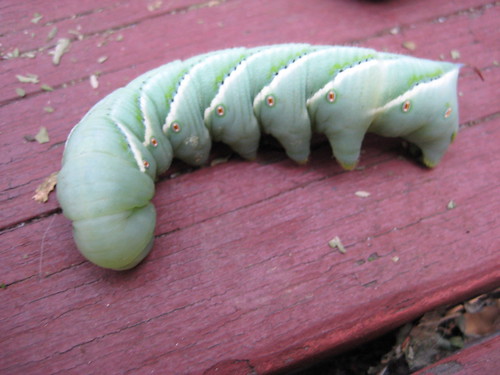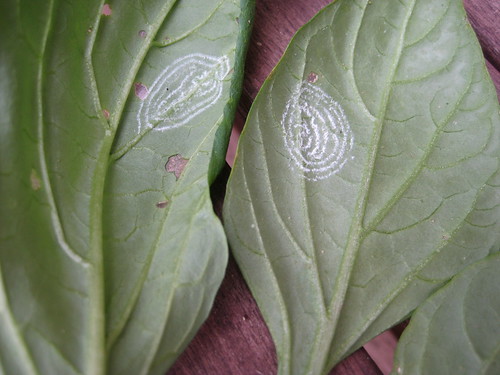Tomato Hornworm
These chubby green caterpillars are are pretty common in summer gardens, from what I can tell. I have certainly had them every year I've grown tomatoes. In their behavior, they act very much like the main character in a book my dad used to read me, The Very Hungry Caterpillar
Verdict: Foe
Telltale signs: Large chunks of leaves missing, entire stems stripped of leaves, bites out of fruit
How to get rid of them: The best way for a small gardener is to find and pick off tomato hornworms by hand. They are kind of gross to touch when they get big and squishy, as in the image above, so wear gloves if you need to. As I mentioned, tomato hornworms tend to blend in, but you can sometimes find them by following their poop. Tomato hornworm droppings can looks like tiny black bits of dirt on a leaf or, if the caterpillar is really big, large green bits. I usually spend a couple of minutes in the morning looking over my tomato plants, scanning for bites out of leaves and then turning those leaves over to look for caterpillars. When you find one, pick it off with your hands and feed it to your chickens. (If you don't have chickens, you can drown them in a bucket of soapy water.)
Spider Mite
I have had a couple of infestations of spider mites on my eggplants. The mites themselves are tiny red bugs, and they make fine webs over and between the leaves of plants. Eventually, the leaves with the webbing die. While they're not as immediately destructive as other garden pests, they're not very good for a vegetable crop, so it's best to get rid of them when they appear.
Verdict: Foe
Telltale signs: Fine webbing over leaves, tiny red dots on leaves (those are the mites)
How to get rid of them: Some people use soap sprays, but I have found that the best way to get rid of spider mites is to just blast them with water using a hose sprayer. Every night for a week or so, blast both the top and underside of leaves with a strong spray of water. This knocks off the mites and also creates humidity, which spider mites hate. It takes about a week, but usually I can get rid of spider mites with this method.
I have had a couple of infestations of spider mites on my eggplants. The mites themselves are tiny red bugs, and they make fine webs over and between the leaves of plants. Eventually, the leaves with the webbing die. While they're not as immediately destructive as other garden pests, they're not very good for a vegetable crop, so it's best to get rid of them when they appear.
Verdict: Foe
Telltale signs: Fine webbing over leaves, tiny red dots on leaves (those are the mites)
How to get rid of them: Some people use soap sprays, but I have found that the best way to get rid of spider mites is to just blast them with water using a hose sprayer. Every night for a week or so, blast both the top and underside of leaves with a strong spray of water. This knocks off the mites and also creates humidity, which spider mites hate. It takes about a week, but usually I can get rid of spider mites with this method.
Giant Whitefly
Giant whiteflies make a fluffy, white "beard" on the underside of leaves, eventually destroying them and weakening the plant. (I once had a hibiscus in my front yard that was completely infested with whiteflies, and eventually I had to take it out.) Despite their name, giant whiteflies are pretty small. They look like tiny, white bugs fluttering around your plant. This year, I found a few giant whitefly egg spirals on the bottom of my pepper leaves (see above). Thus far, they haven't taken hold on any of my plants, so I am not too worried. But I am keeping an eye on my peppers and checking the underside of leaves often for more spirals.
Verdict: Foe
Telltale signs: Small, white spirals on the underside of leaves, or, later, a white, hairy substance on underside of leaves.
How to get rid of them: Remove leaves with spirals. If whiteflies infest your plant, try a soap spray . This is supposed to work fairly well, although I haven't tried it yet.
. This is supposed to work fairly well, although I haven't tried it yet.
This post is getting rather long, so I think I will break it into two parts, and write about the rest of the bugs in my garden in another post. I hope the above information has been helpful. Stay tuned for Part 2 of this Tip, coming soon.
Previous Tips from a Trial and Error Gardner:
Tip #1: Start Your Seeds Early
Tip #2: Mulch Like You Mean It
Tip #3: Location Matters
Telltale signs: Small, white spirals on the underside of leaves, or, later, a white, hairy substance on underside of leaves.
How to get rid of them: Remove leaves with spirals. If whiteflies infest your plant, try a soap spray
This post is getting rather long, so I think I will break it into two parts, and write about the rest of the bugs in my garden in another post. I hope the above information has been helpful. Stay tuned for Part 2 of this Tip, coming soon.
Previous Tips from a Trial and Error Gardner:
Tip #1: Start Your Seeds Early
Tip #2: Mulch Like You Mean It
Tip #3: Location Matters




Long time reader, first time poster. Thanks for doing this roundup. Right after I read your post, I found the telltale sign of that white spiral on one of my pepper leaves that hadn't been there in the morning! You saved me hours of googling! Thanks!
Lisa
I just discovered tomato hornworms on my plant and your blog post was very helpful. Thanks!
I found a caterpillar very similar a couple of days ago, the only difference was the little horn. Mine was blue and the dots were white. Do you think it was another breed or do you think it was old and becoming a cocoon?
I think the blue dotted caterpillar is likely a different variety. Tomato hornworms are very common, but there are definitely all kinds of caterpillars in a typical garden. I'm thinking you can deal with your blue spotted guy in the same way you'd deal with a hornworm, though. Pick it off by hand.
I found one of these hornworms on my tomato plant. I picked him off and put him in a jar and then added a tomato sucker stem. For more than 24 hours he laid on the bottom unmoving and I believed him to be dead. I went to discard him, only to find he had crawled up to the top of the stem. Upon closer inspection I found half way up the stem where he had attached himself and molted.
Thanks for sharing this. I started a garden for the first time this year and was quite surprised at the vengeance with which bugs attacked it!
I appreciate your tips, too. Thanks again.
my fight has begun already. this year I hope to win. flea beetles are my worst enemy.
I sprinkle corn meal on my tomato plants and it upsets the digestive system of the horned tomato worms and they don't present much of a problem anymore..